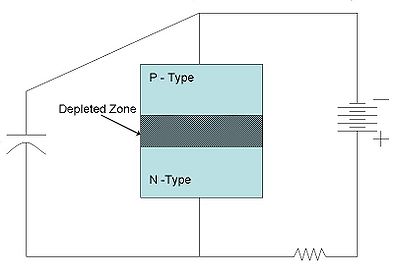Review Questions
Jump to navigation
Jump to search
Theory of SiPM operation: review questions
- What is a semiconductor? How is it differ from a conductor? from an insulator?
- Sketch a diagram of a semiconductor diode and label the parts. What is meant by the deletion region? Where is the depletion region in a diode?
- What is meant by the term bias voltage in a diode circuit? What does it mean to say that a diode is reverse biased?
- What is diode breakdown and how does it occur? What normally happens when a diode is reverse-biased above the breakdown voltage?
- Describe a way that a reverse-biased diode be connected in a circuit so that it can survive breakdown. What modification to the circuit is required to make the diode produce avalanche pulses?
- What is a photodiode? How does it differ from an ordinary diode?
- What is an avalanche photodiode? How does it differ form an ordinary photodiode?
- What role does temperature play in the performance of an avalanche photodiode?
- Semiconductor has some properties of a conductor as well as some properties of an insulator. It has a critical temperature T0 below which the semiconductor becomes an insulator and above which it acts as a conductor. Conductors are materials with many free electrons and/or holes that allow electric charge to freely move in response to an electric field. An insulator has its electrons firmly bound therefore does not allow electric charge to move in response to an electric field.
- A depleted region is a region where there are no holes and no free electrons in a semiconductor, therefore making it behave as an insulator. The Depleated Region is the area inbetween the P-type and N-type semiconductors in the diode.
- Bias voltage is the voltage it takes to get the diode to start conducting. Below a certain voltage, the diode won't conduct current even in the forward direction. It is the voltage which allows the electrons and holes to overcome the depleted zone and meet with each other, creating current. Reverse Biased means that the positive end of the battery is connected with the n-type semiconductor and the negative end is connected with the p-type semiconductor. This sucks all the electrons from the n-type region and fills in all the holes in the p-type region, increasing the size of the depleted zone.
- Diode breakdown happens when a reverse biased diode is subjected to so much voltage that it conducts in the reverse direction. When a diode is reverse-biased past the breakdown voltage, it stays enters metastable state, in which any at free charge would start an avalanche and make the diode draw so much current that it may damage the diode.
- If a resister is placed in the circuit, it prevents the current from getting too high and stops the diode from being fried. To make an avalanche-like pulse, you would also a capacitor that would be connected in parallel to the diode. It serves as a temporary battery that supplies enough current to create an initial breakdown pulse, after which the capacitor is drained and the resister reduces the voltage below breakdown and the breakdown condition is no longer met and the avalanche is self-quenched.
- A Photodiode is a diode that is especially sensitive to light. When it is reversed biased, it conducts when it is exposed to light and blocks current when it is in the dark. It contains a very thin doped region and a very thick depleated zone in which photons are absorbed. It is usually packaged in a clear glass or plastic case that allows light through to maximize the effect it has upon the diode.
- An avalanche photodiode is a photodiode designed in such a way that it releases a pulse of electrons per photon instead of just one. When it is reverse-biased above the breakdown voltage, through the process mentioned above, the avalanche photodiode uses the energy from the photon to release photodiode from its metastable state and create a pulse.
- Temperature is a measure of the size of the vibrations of atoms in a solid. It also reflects the random motion of electrons in the space between the atoms. A higher temperature means larger random thermal fluctuations. A higher temperature also means that there is more chance for electrons to jump to a higher quantum state. Some of these thermal fluctuations have enough energy to create a electron-hole pair and release the photodiode from its metastable state similar, and produce a pulse similar to what is created by a photon. The current generated by thermal avalanches is known as dark current because it is present even in the dark.
